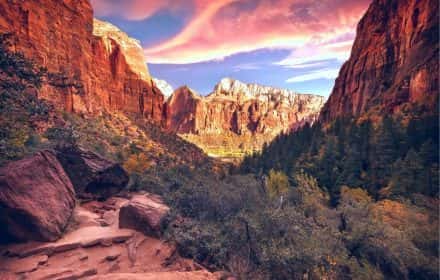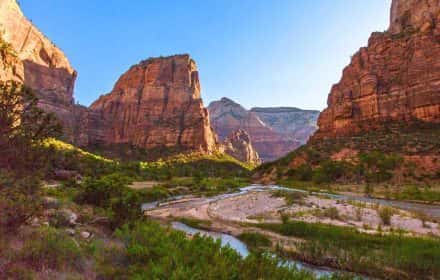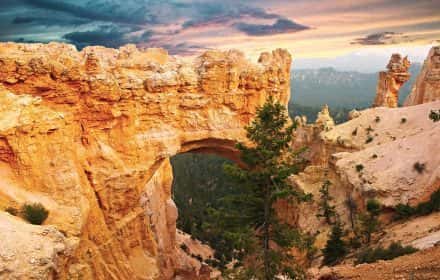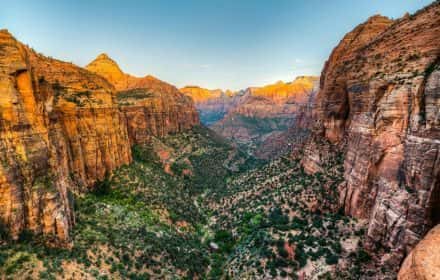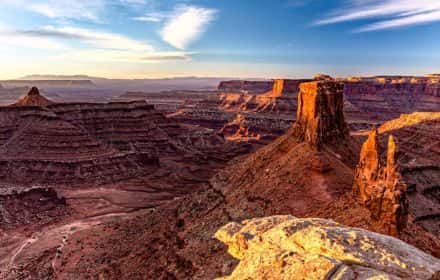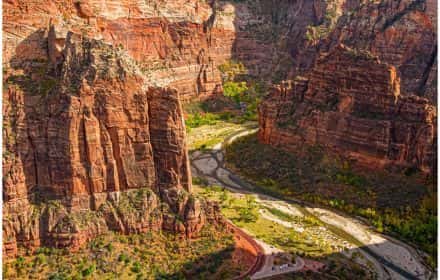This site uses affiliate links, meaning that if you make a purchase through our links, we may earn an affiliate commission.
Nestled within Utah’s stunning landscapes, Zion National Park is a haven for outdoor enthusiasts and nature lovers. With sweeping canyons and breathtaking vistas, this park is a visual feast that will leave you in awe!
Whether you are planning to conquer the famous Angel’s Landing hike, experience the sunrise at the Narrows, or simply soak in the serenity of this remarkable place, our 11 tips for first visit to Zion will ensure your adventure is as rewarding as possible.
GOOD TO KNOW: Zion National Park can easily be combined with a visit to Bryce Canyon National Park: Zion to Bryce Canyon in 3 Days – Perfect Rod Trip Itinerary.
Looking for a longer road trip? How about this Epic 7-Day Road Trip Through Utah National Parks?
- 1. 11 Tips for First Visit to Zion
-
- 1.1. Smart Tips for Getting to Zion
- 1.2. Optimize Your Visit by Choosing the Perfect Time
- 1.3. Explore Your Options for Accommodations
- 1.4. Entrance Fees (Get the Most Value from Your Visit)
- 1.5. Smart Tips for Navigating Inside Zion National Park
- 1.6. Dive Into Some Interesting Facts About Zion
- 1.7. Test Your Bravery on Angels Landing Trail
- 1.8. Explore The Narrows
- 1.9. Bike the Pa'rus Trail
- 1.10. Go on a Scenic Drive through Zion Canyon
- 1.11. Venture Out to Kolob Canyons
- 2. Intrepid Scout's Zion National Park Tips for First-Time Visitors
11 Tips for First Visit to Zion
Smart Tips for Getting to Zion
Getting to Zion National Park efficiently and hassle-free is essential for maximizing your time in the park.
Here are tips to help you arrive with ease:
- By Air: The nearest major airport is McCarran International Airport (LAS) in Las Vegas, Nevada.
Alternatively, you can fly into Salt Lake City International Airport (SLC) in Salt Lake City, Utah. From either of these airports, you will need to rent a car and drive to Zion.
There are smaller Regional Airports in St. George (SGU), Utah, and Cedar City (CDC), Utah.
GOOD TO KNOW: From my personal experience, Salt Lake City and Las Vegas International Airports have the most inexpensive flights. However, you should check all of these airports and see which one is the best option for you. I usually use Skyscanner when I am searching for flights.
- By Car: If you decide to fly into one of the airports and then rent a car, here are the distances and approximate time it would take you to get to Zion:
Driving from Las Vegas, Nevada – 160 miles (2 h 30 min)
Driving from Salt Lake City, Utah – 308 miles (4 h 30 min)
Driving from Cedar City, Utah – 58 miles (1 h 5 min)
Driving from St. George, Utah – 41 miles (1 h)
- Guided Tour: Consider joining a guided tour that includes transportation to and from Zion National Park. This allows you to relax and enjoy the journey while a knowledgeable guide takes care of the logistics.
PRO TIP: You might like this tour: Full-Day Tour to Zion National Park from Las Vegas. This tour will pick you up from your hotel in Las Vegas and take you to and from Zion. It includes breakfast, lunch, plus entrance fees for a completely stress-free day.
Optimize Your Visit by Choosing the Perfect Time
Zion is a great destination to visit at any time of the year. And, it is open 24 hours a day, every day of the year. However, some facilities reduce the opening hours during winter. I have visited Zion so many times at different times of the year and I have to honestly say that it is an awesome place to see no matter what month you visit!
Here are some insights to help you determine the best time for your visit:
- Spring (March to May): Springtime brings blooming wildflowers, cascading waterfalls, and milder temperatures, making it a perfect time to explore Zion.
However, be aware that spring is also a popular time for visitors, resulting in larger crowds. Plan your visit during weekdays or consider early morning or late afternoon outings to avoid peak times.
- Summer (June to August): Summer offers longer days and a wide range of outdoor activities. It’s a great time for hiking, river tubing, and exploring the park’s scenic wonders.
Keep in mind that summer can be hot, with temperatures often exceeding 100°F (38°C). Plan your activities accordingly, stay hydrated, and seek shade during the hottest parts of the day.
- Fall (September to November): Fall is one of the best times to visit Zion as the landscape transforms into vivid autumn colors. The weather is generally pleasant, and the crowds start to thin out after the peak summer season.
Be prepared for cooler temperatures in the later months of fall and consider layering your clothing accordingly.
- Winter (December to February): There are fewer visitors in winter and you will have a chance to witness the park’s majestic beauty in a different light.
Although snow can create a stunning landscape, certain trails and facilities may be closed or have limited access. Check for weather updates and be prepared for cold temperatures.
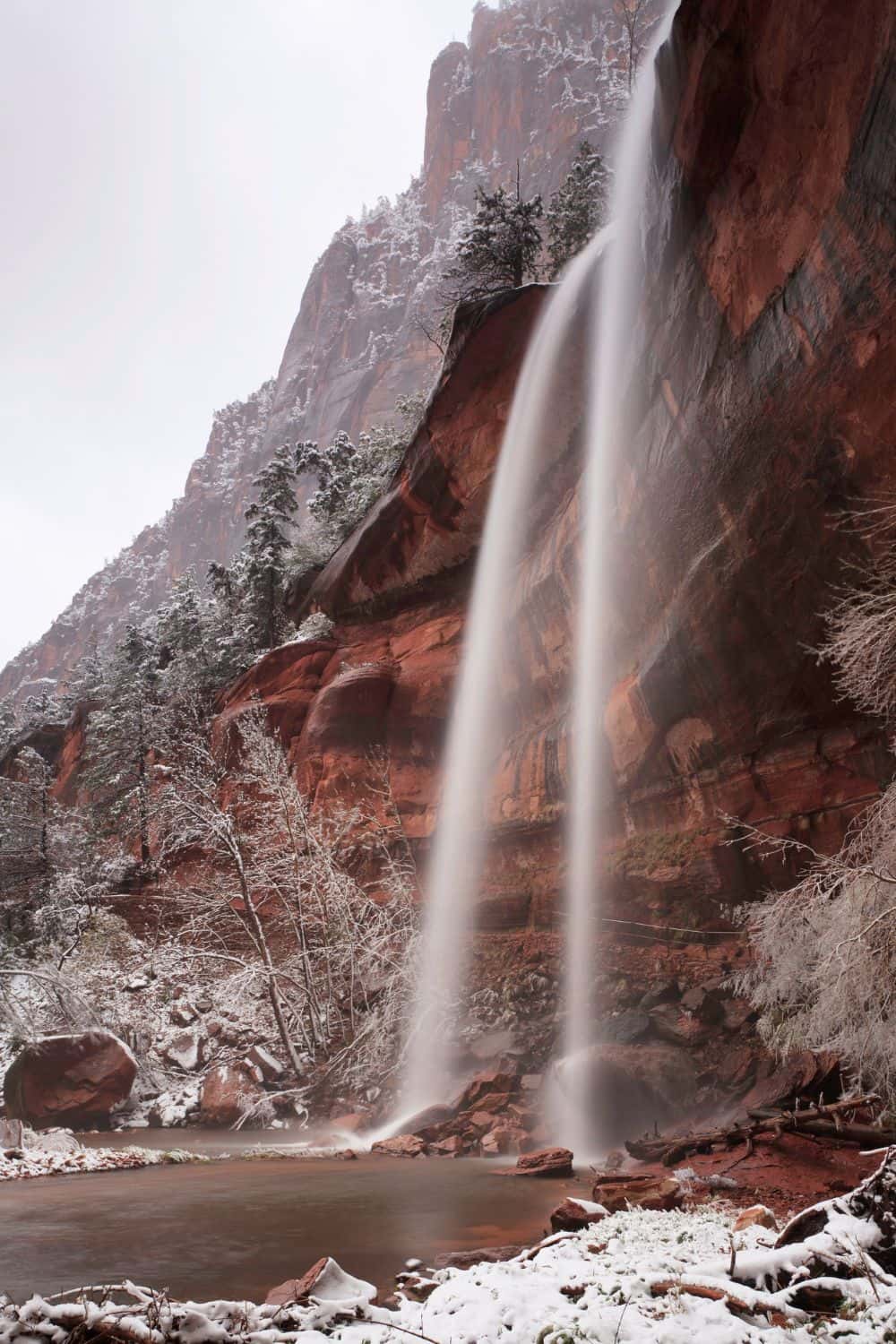
Emerald Pools Trail in Winter
Explore Your Options for Accommodations
Choosing the right place to stay during your visit to Zion National Park is crucial for convenience and maximizing your time in the park. Here are some tips on finding the perfect accommodation:
- Staying Inside the Park: Hands down, nothing beats staying inside the park! However, accommodations are very limited and you will need to make reservations at least a year in advance.
Zion Lodge is the only hotel inside the park. It is open year-round and has several different types of accommodations like cabins, hotel rooms, and suites. My recommendation is to get a cabin. They all have gas-log fireplaces, private porches, full baths, microwaves, and mini-refrigerators.
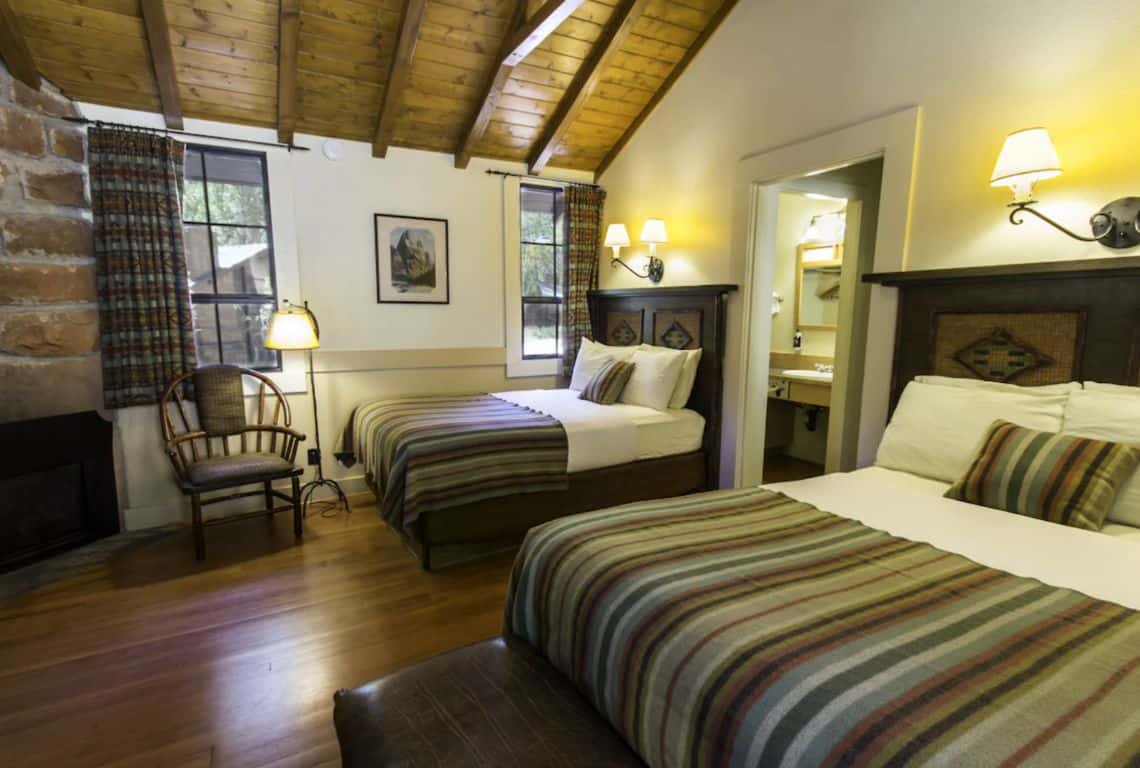
Zion Lodge
For those seeking a more immersive outdoor experience, Zion National Park has several campgrounds available.
South and Watchman Campgrounds are inside the Zion Canyon, Lava Point Campground is about 1-hour drive from Zion Canyon on the Kolob Terrace Road.
South Campground is located about 0.5 miles from the South Entrance. It is open from March through October. It has 117 sites.
Watchman Campground is located about 0.25 miles from the South Entrance. Tent and electric campsites are available year-round. Watchman Campground has 190 sites.
PRO TIP: Reservations for both South and Watchman Campgrounds need to be made well in advance at Recreation.gov.
- Staying Near the Park: If you prefer a wider range of accommodation options or want to explore beyond the immediate park vicinity, consider staying in nearby towns like Springdale, Hurricane, or St. George.
These towns offer a variety of hotels, vacation rentals, and other lodging choices. They also provide easy access to amenities, dining options, and additional attractions in the region.
GOOD TO KNOW: Springdale, UT is my top choice. It is conveniently right at the entrance to Zion and it is the perfect getaway to Zion National Park. There are many options of where you can stay in Springdale and several good places where to can grab a bite to eat.
I stayed in Springdale several times and my two top choices are Hampton Inn & Suites Springdale/Zion National Park, and SpringHill Suites by Marriott Springdale Zion National Park. Both places are clean and comfortable, and the location is perfect.
PRO TIP: If you are in Springdale, UT then head to Oscar’s Cafe. Everything on the menu is simply delicious! However, make sure to try the murder burger or the pork burrito. Another place you should check out is Spotted Dog. My recommendation is to try the Southwest Chicken with wild rice and fresh mango avocado salsa.
Entrance Fees (Get the Most Value from Your Visit)
When planning your visit to Zion National Park, it is essential to understand the entrance fees and how to make the most of your investment. Here are some key tips regarding entrance fees:
To visit Zion National Park, you must purchase a recreational use pass (at the entrance to the park). The pass is valid for 7 consecutive days and costs $35 per vehicle, and $20 per person (on foot, bicycle, motorcycle).
INTREPID’S PRO TIP: Consider purchasing the America the Beautiful Pass, also known as the National Parks Pass. This annual pass grants access to more than 2,000 federal recreation sites, including national parks, monuments, and wildlife refuges across the United States. This pass can offer significant cost savings if you plan to visit multiple national parks within a year.
Smart Tips for Navigating Inside Zion National Park
Getting around Zion National Park efficiently is key to maximizing your time and experiencing all the park has to offer. Here are some tips to help you navigate the park:
- Shuttle System (Zion Canyon Shuttle): The Zion Canyon Shuttle is the primary mode of transportation within the park during the peak season (typically from late March to early November). It operates along the Zion Canyon Scenic Drive, which provides access to popular trailheads and points of interest.
INTREPID’S PRO TIP: During peak times, the shuttle can get crowded, so plan accordingly and consider starting your day early to secure a seat. Additionally, be aware of the shuttle’s last departure time to ensure you do not miss the return trip.
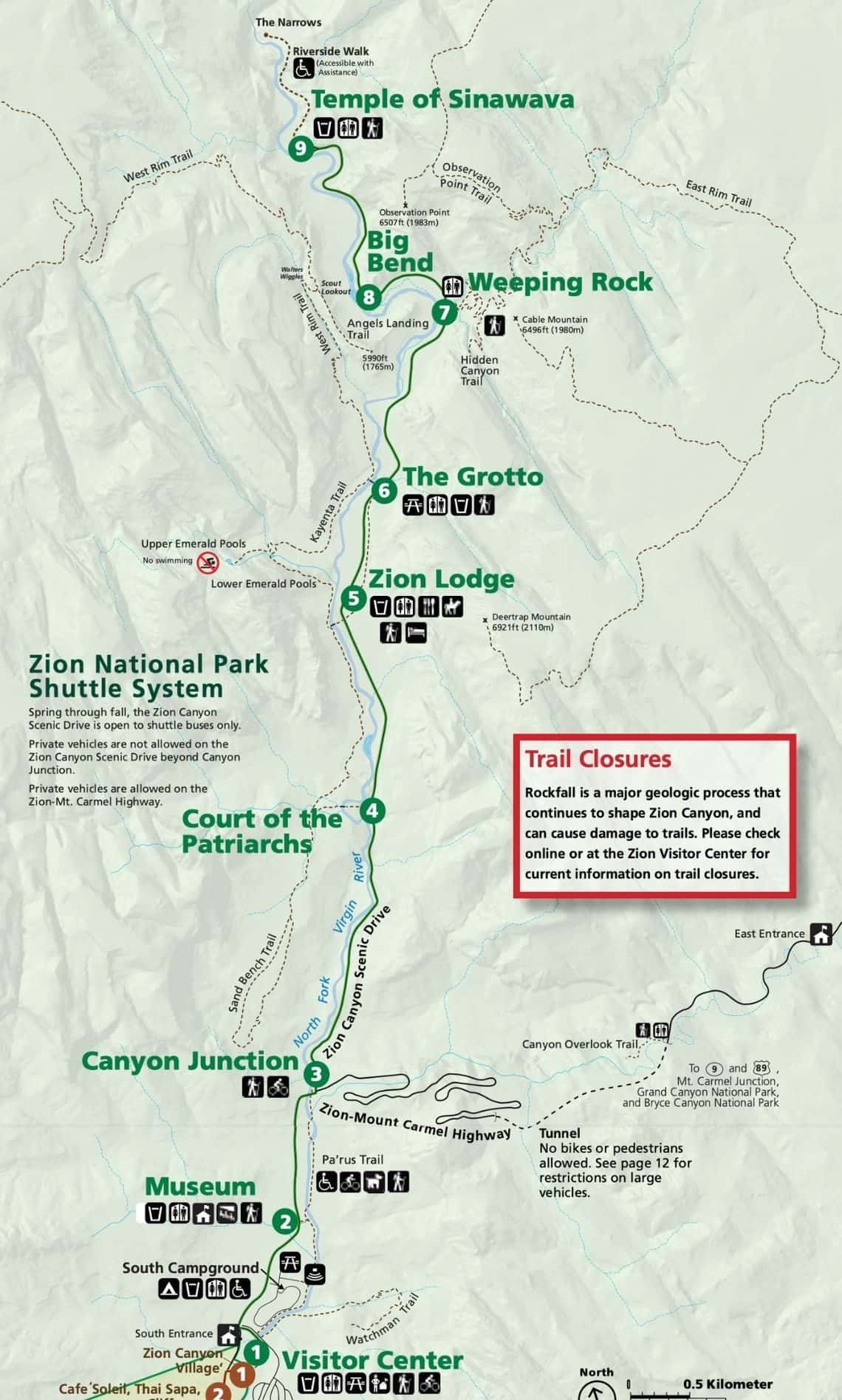
Map of Zion Canyon Shuttle Stops. Image Credit: NPS
- Springdale Shuttle: The second shuttle route is located in the Town of Springdale. It stops at 9 locations in the town of Springdale and picks up and drops off visitors at the park’s pedestrian/bike entrance.
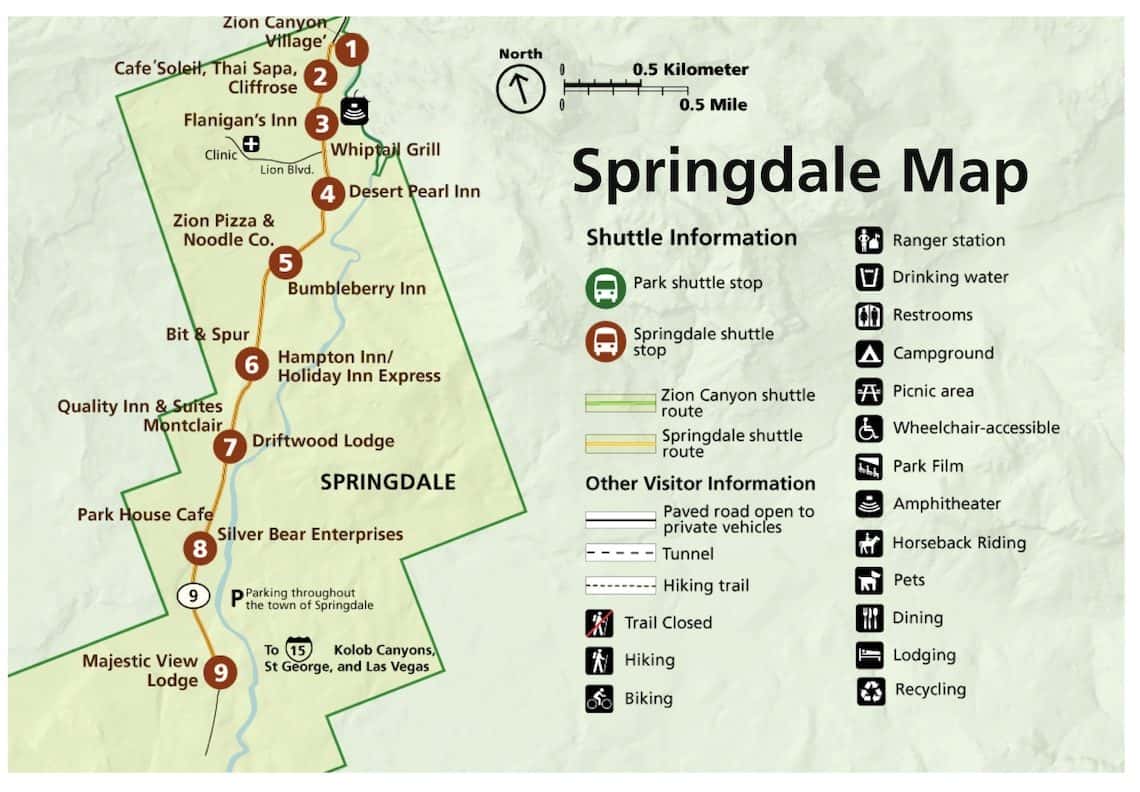
Map of Springdale Shuttle Stops. Image Credit: NPS
- Private Vehicle Restrictions: Private vehicles are allowed on the Zion Canyon Scenic Drive during the winter season (typically from November to late March) when the shuttle service is not operating. However, parking within the canyon can be limited, so it’s advisable to arrive early to secure a parking spot.
- Bicycles: Bicycles are permitted on the Zion Canyon Scenic Drive during the winter season and can be a great way to explore the park at a leisurely pace. However, during the peak season, bicycles are not allowed on the Zion Canyon Scenic Drive when the shuttle service is in operation.
There are designated bicycle trails and paths within the park, such as the Pa’rus Trail, which offers a scenic route suitable for both biking and walking.
- Hiking and Walking: Many of Zion National Park’s trails can be accessed by foot from the shuttle stops along the Zion Canyon Scenic Drive.
- Private Tours and Shuttles: If you prefer a guided experience or want to explore specific areas of the park not accessible by the shuttle, consider booking a private tour or shuttle service.
Check out these private tours: Bryce Canyon and Zion National Park Day Tour with Lunch from Las Vegas. This tour departs from Las Vegas and covers both Zion and Bryce National Parks.
Zion and Bryce Canyon National Parks Small Group Tour from Las Vegas. This is a small group private tour that is limited to only 14 people and covers both Zion and Bryce in one day.
Dive Into Some Interesting Facts About Zion
Beyond its awe-inspiring beauty, Zion National Park holds a wealth of fascinating facts that will add depth to your visit.
Here are some cool facts about Zion National Park to enhance your experience:
- History: The United States Congress established Zion National Park on November 19, 1919. A separate Zion National Monument, the Kolob Canyons area, was proclaimed on January 22, 1937, and was incorporated into the park on July 11, 1956. Zion National Park covers an area of 229 square miles.
- Origin of Its Name: The word Zion is derived from ancient Hebrew. Mormon pioneers, the initial Anglo-European settlers, arrived in the area in the late 1800s. The credit for naming the area Zion goes to them. In ancient Hebrew, Zion means refuge or sanctuary.
- Geological Marvels: Zion National Park is renowned for its stunning geology. The towering sandstone cliffs and canyons were formed over millions of years through the process of erosion.
The famous red rock found in Zion is part of the Navajo Sandstone formation, known for its vibrant hues ranging from cream to deep red. These sandstone formations are the result of ancient sand dunes that were compacted and cemented over time.
One of the world’s largest natural freestanding arches can be found in Zion National Park. It is known as Kolob Arch and it is 287 feet long.
- Virgin River: The Virgin River is the lifeblood of Zion National Park, carving through the stunning canyons and shaping the landscape. It has played a crucial role in shaping the park’s iconic features, such as The Narrows and Zion Canyon.
The river’s name, “Virgin,” is said to have been given by the early Mormon settlers, who were inspired by the untouched and pure nature of the river.
The Zion Canyon is approximately 2,000 feet deep and it took millions of years for it to get carved by the Virgin River.
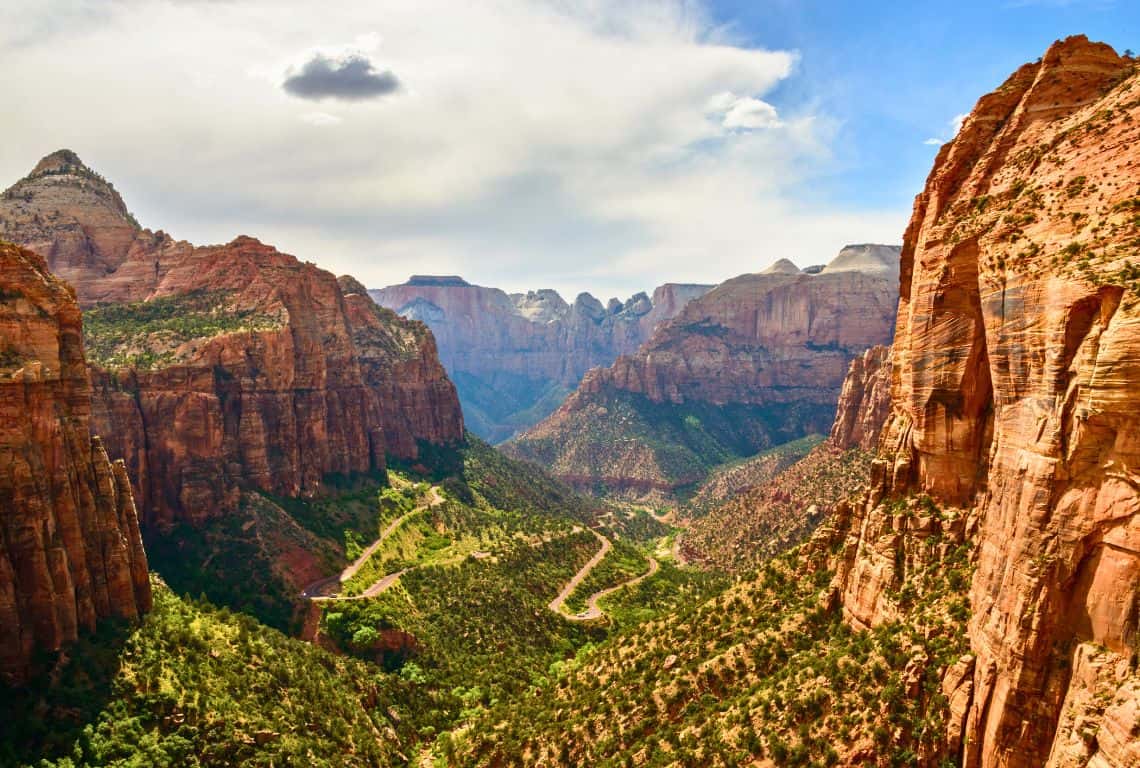
Canyon Overlook / Tips for First Visit to Zion
- Biodiversity: Despite its relatively small size, Zion National Park boasts an incredible diversity of plant and animal species. The park is home to over 900 species of plants, including a variety of desert plants, unique wildflowers, and majestic trees like the ponderosa pine and cottonwood.
Wildlife enthusiasts will have the chance to spot a range of animals, including mule deer, bighorn sheep, mountain lions, and a rich variety of bird species.
Zion National Park is home to one of the most endangered species, the California Condor.
- Dark Skies: With minimal light pollution, Zion National Park offers exceptional stargazing opportunities. The park has been designated as an International Dark Sky Park, making it an ideal location to witness the brilliance of the night sky and spot constellations, planets, and even the Milky Way.
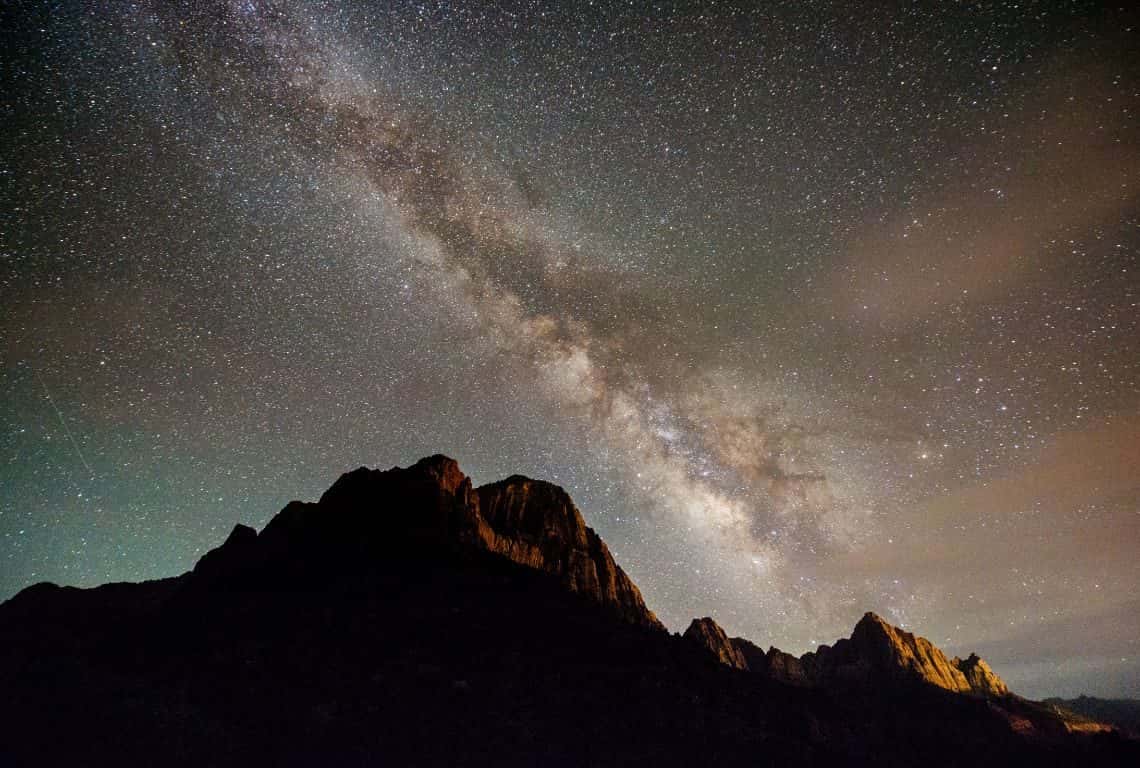
Watchman and Milky Way
- Human History: Zion National Park has a rich human history that dates back thousands of years. Native American tribes, including the Southern Paiute people, have inhabited the area for centuries, leaving behind traces of their culture and connection to the land.
In addition, Zion was home to the Anasazi, a civilization, which thrived around 1,500 BC. Today, you can find traces of their network of roads, sandstone villages, and rock gardens throughout the park.
The park’s rock art and artifacts offer a glimpse into the lives and traditions of these ancient cultures. Be sure to visit the Zion Human History Museum to learn more about the park’s captivating past.
Test Your Bravery on Angels Landing Trail
Test your bravery on the thrilling Angels Landing Trail. Ascend steep switchbacks and traverse a narrow ridge to reach the summit, where panoramic views of Zion Canyon await.
GOOD TO KNOW: Before setting out, it’s important to note that Angel’s Landing is a highly popular hike, and due to its narrow and exposed sections, visitor safety is a top priority. As of the latest update, the National Park Service has implemented a reservation system for accessing the trail, aimed at managing the number of hikers and ensuring a safe and enjoyable experience for all.
To secure your spot, you are required to participate in a lottery system. Register for the lottery HERE. Reservations can fill up quickly, especially during peak seasons, so it’s advisable to plan and check for availability as early as possible.
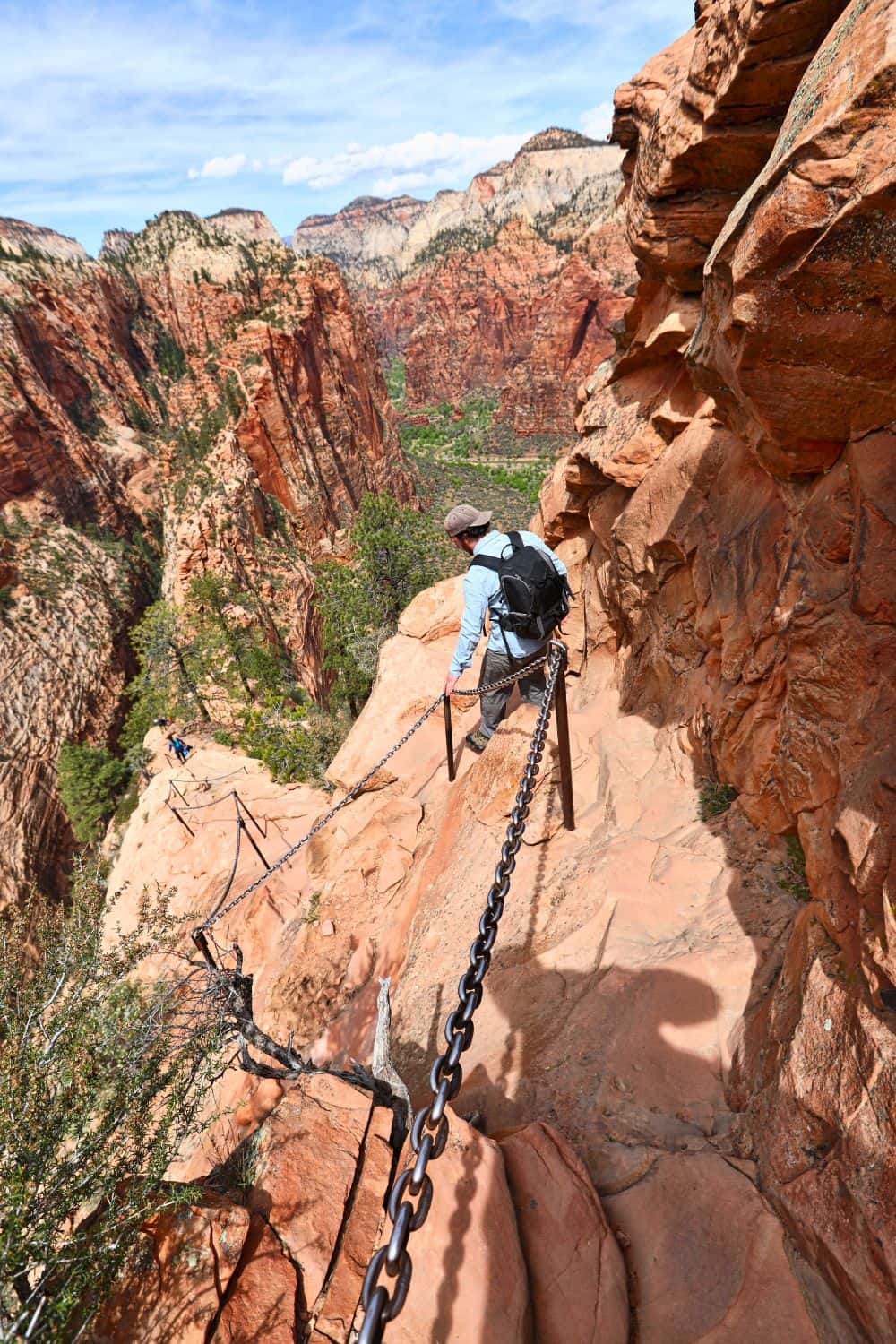
Angel’s Landing Trail / Tips for First Visit to Zion
Explore The Narrows
Embark on a unique and unforgettable adventure by wading through the Virgin River in The Narrows. Hiking between towering canyon walls and immersing yourself in this awe-inspiring slot canyon is an experience like no other.
GOOD TO KNOW: You do not have to traverse the entire route. Even a brief immersion in this awe-inspiring wonderland will make your visit to Zion National Park unforgettable.
PRO TIP: It’s important to note that hiking The Narrows requires proper preparation and equipment. Renting or bringing appropriate gear, such as sturdy footwear, neoprene socks, and a hiking pole, is highly recommended to ensure your safety and enhance your experience.
Check the weather and river conditions before setting out, as flash floods can occur and make the hike dangerous or even impossible.
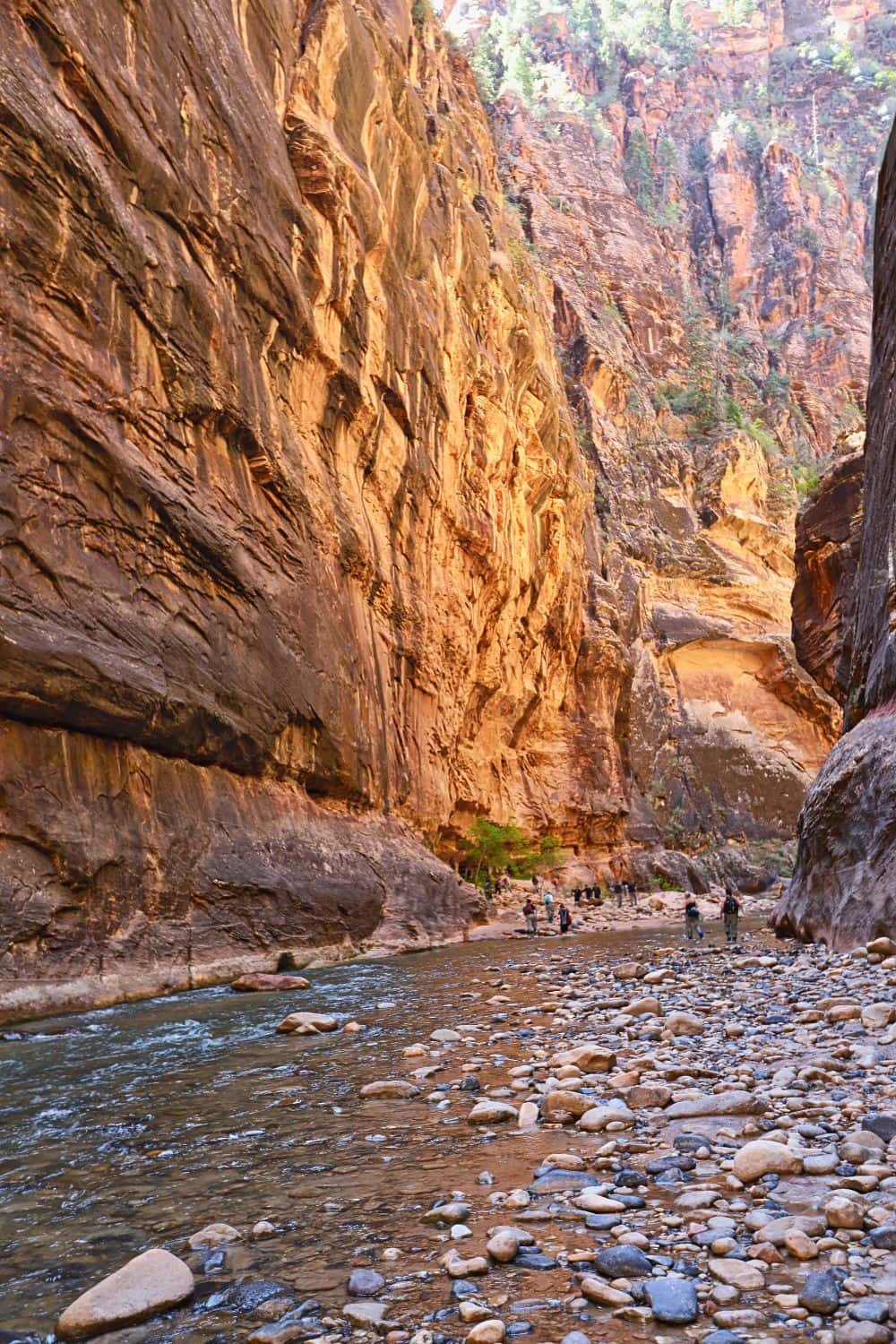
Zion Narrows / Zion National Park Tips for First Time Visitors
Bike the Pa'rus Trail
Rent a bicycle and cruise along the scenic Pa’rus Trail. This paved pathway provides beautiful views of the Virgin River and surrounding landscapes, offering a leisurely way to explore the park.
GOOD TO KNOW: Pa’rus Trailhead is located at the Visitor Center. The trail goes 1.75 and ends at Canyon Junction.
However, you may continue on the main road in the canyon, which goes for 6 miles. The main road ends at the Temple of Sinawava, which is shuttle stop number 9.
Another option is to take a shuttle to the Temple of Sinawava. You simply put your bike on the shuttle bike rack and ride to the Temple of Sinawava. From the Temple of Sinawava, you will ride downhill most of the way down the canyon. However, I need to mention that there is a significant uphill grade between Weeping Rock and the Grotto.
INTREPID’S PRO TIP: If you need to rent a bike, then you can do it in Springdale, Utah. Zion Cycles, located in Springdale has all kinds of bikes that you can rent. Another option is to rent your bike at Zion Lodge, which is located about halfway up the canyon road.
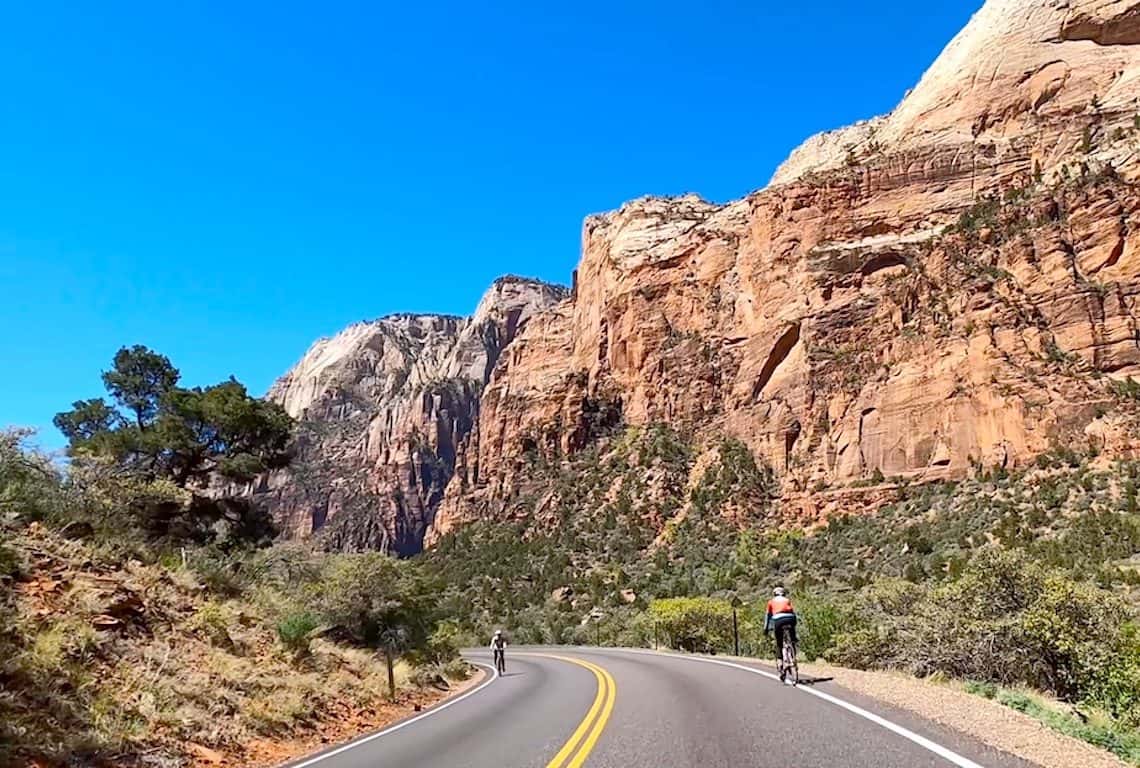
Biking in Zion
Go on a Scenic Drive through Zion Canyon
A scenic drive through Zion Canyon is an absolute must-do for any visitor to the park. Sit back, relax, and enjoy the breathtaking beauty that unfolds around every bend.
GOOD TO KNOW: The Zion Canyon Scenic Drive stretches for approximately 6 miles (9.7 km) within the park, showcasing some of the most awe-inspiring vistas and rock formations.
As you drive along this scenic route, you will be treated to panoramic views of towering sandstone cliffs, cascading waterfalls, and lush greenery.
The drive is dotted with several pullouts and viewpoints, allowing you to pause, stretch your legs, and fully appreciate the grandeur of the canyon. Don’t miss iconic stops like Canyon Junction, Court of the Patriarchs, and Zion Lodge.
PRO TIP: During the peak season (typically from late March to early November), private vehicles are restricted from accessing the Zion Canyon Scenic Drive. Instead, you can park your vehicle in designated parking lots in Springdale and use the free shuttle service to explore the scenic drive and its attractions.
The shuttle system ensures a more enjoyable and eco-friendly experience by reducing traffic congestion and preserving the tranquility of the park.
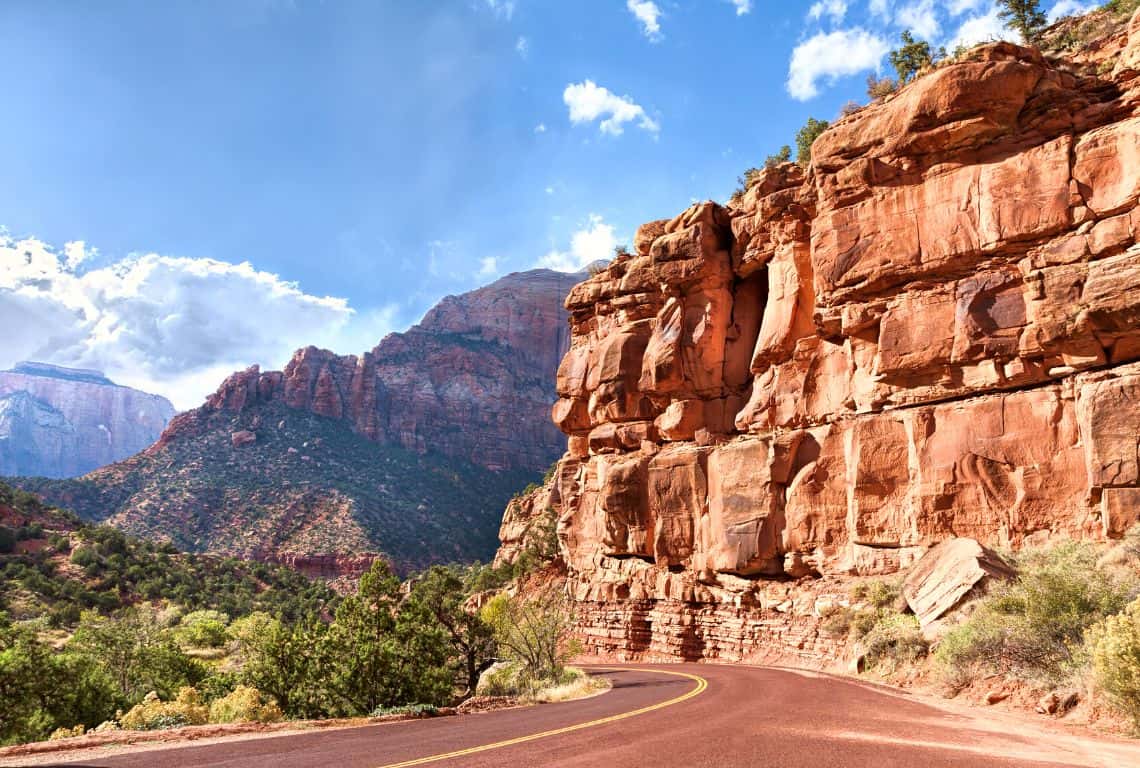
Scenic Drive in Zion / Tips for First Visit to Zion
Venture Out to Kolob Canyons
While Zion Canyon steals the spotlight, a visit to the lesser-known Kolob Canyons is a hidden gem waiting to be explored.
Here is why you should consider adding Kolob Canyons to your list of top experiences in Zion National Park:
- Scenic Drive: The Kolob Canyons Scenic Drive takes you on a breathtaking journey through stunning red rock canyons and majestic vistas. The 5-mile (8 km) paved road showcases the beauty of the Kolob Canyons section of the park.
- Hiking Trails: Kolob Canyons offers several hiking trails that cater to a range of skill levels and time constraints. Consider exploring the following trails:
Taylor Creek Trail: This 5-mile (8 km) roundtrip trail leads you through a picturesque canyon, passing by historic cabins and culminating in the stunning Double Arch Alcove.
Timber Creek Overlook Trail: A shorter but rewarding 1-mile (1.6 km) roundtrip trail that offers sweeping views of the canyons and surrounding landscape.
La Verkin Creek Trail: For those seeking a longer adventure, this 14-mile (22.5 km) trail leads hikers through diverse terrain, crossing creeks and offering opportunities for camping along the way.
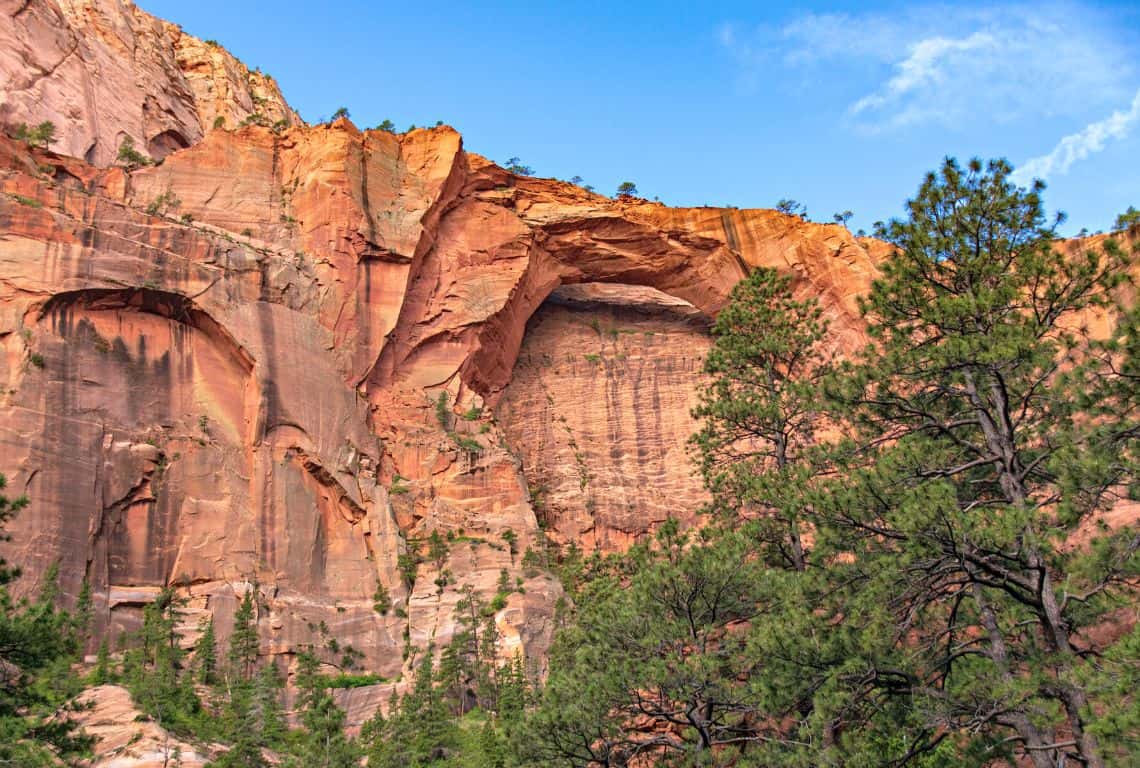
Kolob Arch is the sixth-longest natural arch in the world. Its span is 287.4 feet which is slightly shorter than Landscape Arch in Arches National Park
Intrepid Scout's Zion National Park Tips for First-Time Visitors
- Angel’s Landing Trail Lottery System: If you decide to hike Angel’s Landing Trail in Zion then you need to participate in a lottery system to reserve Timed Entry Ticket.
Visit recreation.gov to sign up for the lottery.
- Stock up on snacks and water, and fill up the gas tank: Get all your groceries (water, snacks, lunch) and fill up the gas tank before entering the park. You will save some money by packing your lunch. There is a restaurant and a small store at Zion Lodge, however, be prepared to pay extra for food and water.
- Be prepared for crowds: Zion National Park is the most visited national park in the United States. 4.5 million people visited Zion National Park in 2019. With that being the case, be prepared for crowds everywhere.
- Park your vehicle in Springdale, UT, and then take the shuttle: Parking is very limited inside Zion National Park and private vehicles are not allowed past the Canyon Junction if the shuttle is operating. Park your vehicle in Springdale and then take the shuttle. There are nine shuttle stops in Springdale.
- Arrive early: The shuttle starts operating at 6 am. Be the first one in the line to board the shuttle. You will be able to experience some solitude on the trails and not wait in line to take a picture.
- Visit Bryce Canyon: A trip to Zion is perfect when paired with a side trip to Bryce Canyon.
Check out my post: Zion to Bryce Canyon: 3-Day Adventure (with Maps and Photos)
Also, get inspired with this Epic 7-Day Road Trip Through Utah National Parks.
Did You Find This Useful?
Why Not Save Tips for First Visit to Zion to Pinterest?
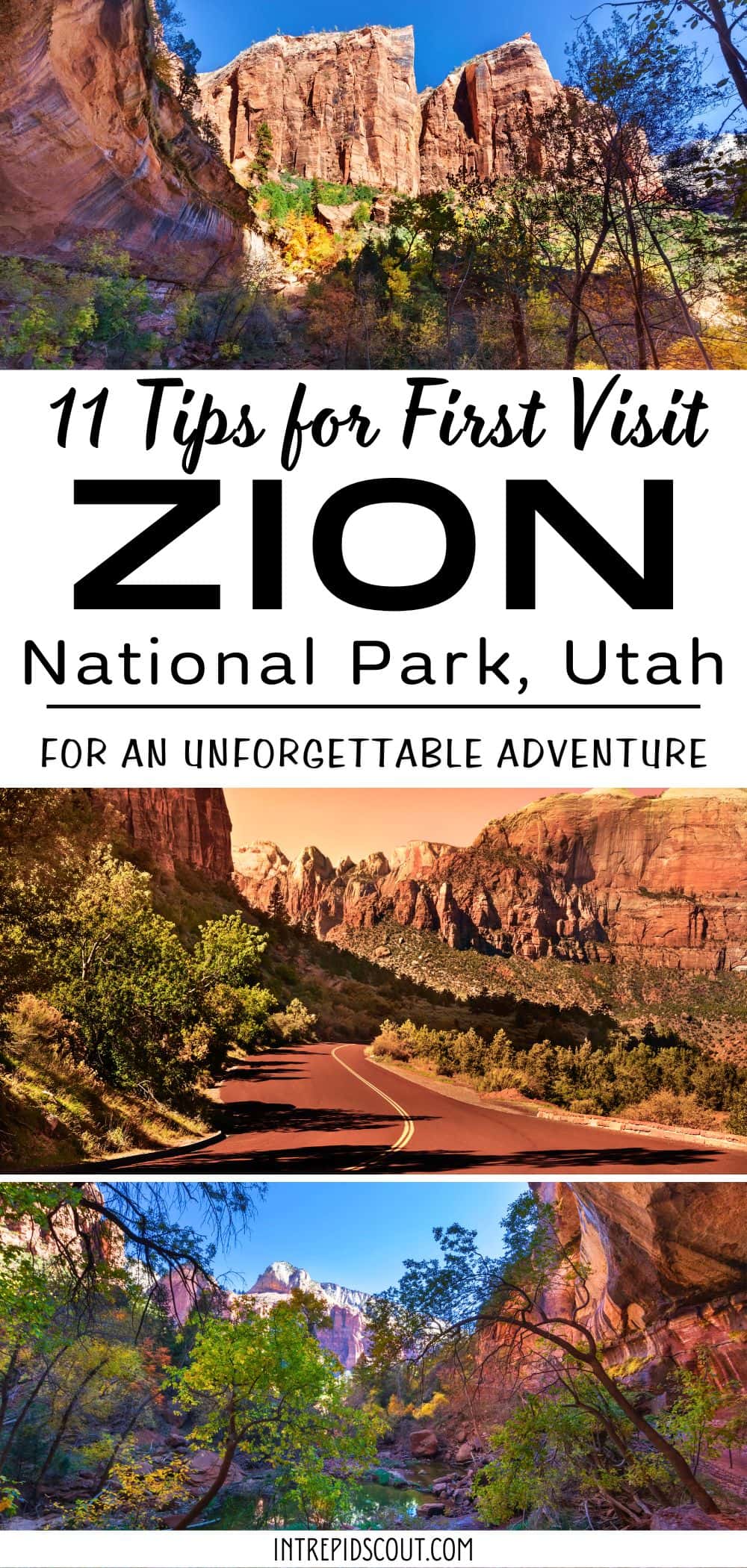
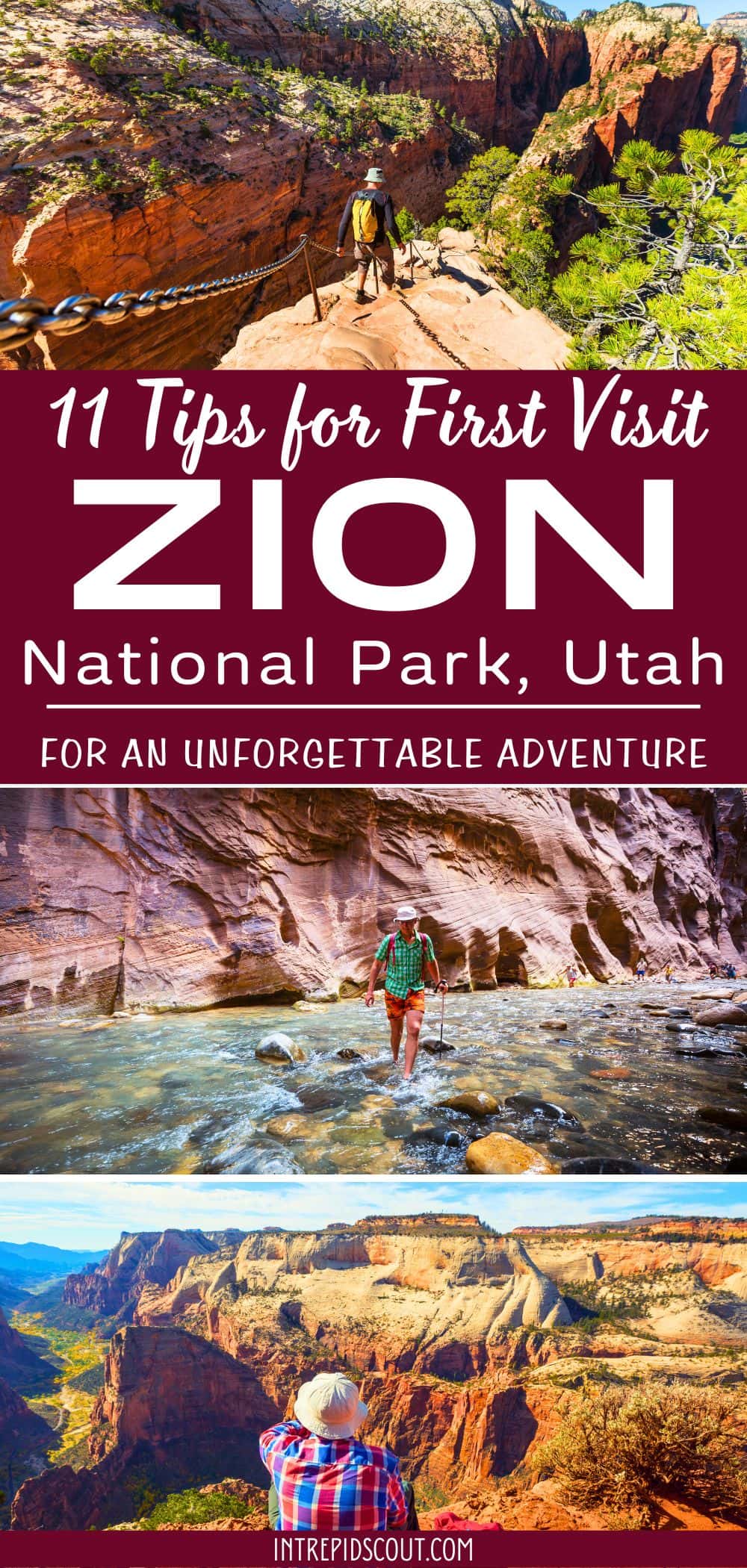
Now, It Is Your Turn, I Would Like to Hear Back from You!
Are you planning a road trip to Zion National Park?
Please let me know! Drop me a quick comment right below!
Click on any of the images below to get inspired and to help you with the planning process for your trip to Zion!
